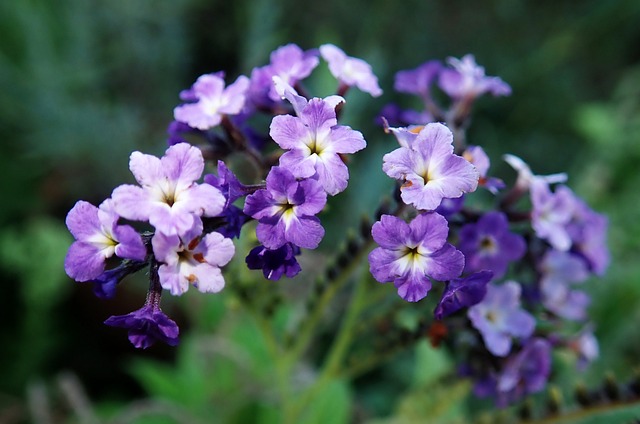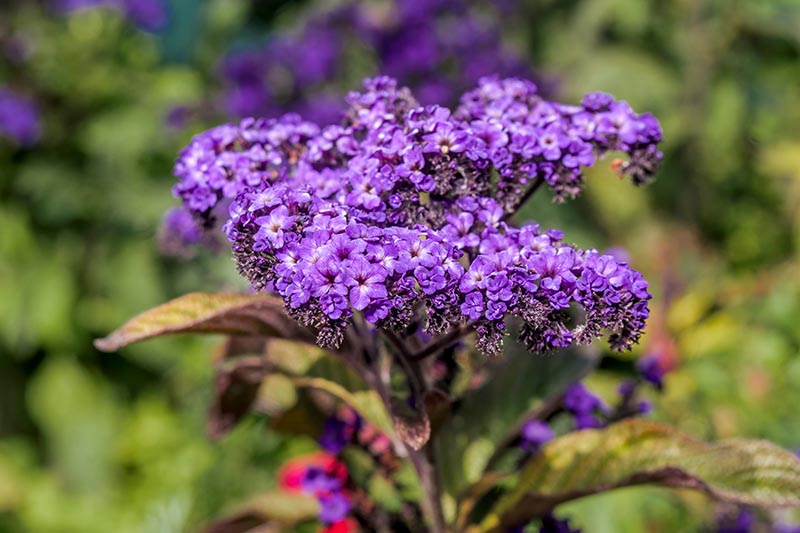Heliotrope flowers, also known as cherry pie flowers or turnsole, are small, fragrant flowers that come in shades of purple, blue, and white. These delicate blooms have been cultivated for centuries and hold a special meaning and symbolism in different cultures around the world. In this article with Impeccable Nest, we will explore the various meanings and symbolism associated with heliotrope flowers. From their historical significance to their modern-day uses, we will delve into the rich and fascinating world of these beautiful flowers.

Myths and Legends Associated with the Heliotrope
The heliotrope features prominently in Greek legends about love and devotion.
The Story of Clytie and Apollo
- Clytie was a water nymph who fell deeply in love with Apollo, the Greek god of the sun
- When Apollo spurned her affections, she spent her days fixed in place, her head following the sun across the sky as Apollo drove his fiery chariot
- The gods took pity and turned her into the heliotrope flower, which continues to turn its blossoms to the sun
This poignant myth links the heliotrope with the themes of unrequited love, longing and devotion.
Heliotrope in Ancient Herbal Medicine
- Ancient Greek herbalists believed the heliotrope had special protective properties
- They prescribed it for poisonous insect and snake bites
- Thought it could make a person invisible if rubbed over the body
- Valued for treating everything from gout to insomnia
These associations reveal how highly the ancients esteemed the magic and healing virtues of this plant.
Heliotrope Flower Meaning: Symbolic
Over the centuries, the heliotrope has accumulated rich symbolic meaning and has become part of the symbolic floral lexicon used in works of poetry, art and literature.
Devotion
The heliotrope flower, also known as the “cherry pie plant” or “turnsole”, is a beautiful and fragrant flower that has been used in gardens and bouquets for centuries. Its name comes from the Greek words “helios” meaning sun and “tropos” meaning turn, which refers to the flower’s tendency to turn towards the sun throughout the day. This unique characteristic of the heliotrope has led to its symbolic association with devotion.
One of the main reasons why the heliotrope is linked to devotion is because of its affinity for the sun. Just like how the flower turns towards the sun, devotion is often described as a strong and unwavering commitment or dedication towards someone or something. The heliotrope’s natural inclination towards the sun reinforces this idea of steadfastness and loyalty, making it a perfect symbol for devotion.
In addition to its physical connection to the sun, the heliotrope’s mythic origins also play a role in its symbolism of devotion. In Greek mythology, there is a story about a nymph named Clytie who was deeply in love with the sun god Apollo. However, Apollo did not return her affections and instead fell in love with another woman. Heartbroken, Clytie spent all her days gazing at the sun, turning her head to follow its movements. Eventually, the gods took pity on her and turned her into a heliotrope flower, forever facing the sun. This tale emphasizes the idea of dedicated love and attentiveness, further solidifying the heliotrope’s association with devotion.
Aside from romantic love, the heliotrope also represents devotion in other types of relationships. It can symbolize loyalty, commitment, and faithfulness in friendships, family bonds, and even one’s devotion to a cause or belief. The flower’s vibrant purple color, which is often associated with royalty and nobility, also adds to its symbolism of devotion as it conveys a sense of honor and respect towards the object of one’s devotion.
The heliotrope flower holds a strong and meaningful symbolism of devotion. Its connection to the sun, both physically and mythically, highlights the idea of unwavering commitment and dedication. Whether it is in romantic relationships or other types of bonds, the heliotrope serves as a reminder to stay devoted and loyal to those we hold dear.
Inner Joy and Bliss
The Heliotrope flower, also known as the cherry pie flower, is a beautiful and fragrant plant that has been used in gardens and bouquets for centuries. It is native to Peru and was first introduced to Europe in the 18th century. The name “heliotrope” comes from the Greek words helios, meaning sun, and tropos, meaning turn, as the flowers were believed to turn towards the sun.
Aside from its stunning appearance, the Heliotrope flower also holds a deep symbolic meaning. Its intoxicating almond fragrance signifies sweetness and delight, making it a popular choice for perfumes and scented candles. But beyond its pleasant scent, this flower conveys a mood of pleasure, elation, and euphoria.
The Heliotrope flower is often associated with joy and happiness, and it is said to represent a blissful state of inner joy and contentment. This meaning is deeply rooted in the flower’s history and cultural significance. In ancient Greece, the Heliotrope flower was dedicated to the goddess Persephone, who was associated with spring and rebirth. It was believed that the flower’s sweet scent could bring joy and happiness to those who smelled it.
In Victorian times, the Heliotrope flower was commonly used in love potions and spells, as it was believed to attract love and happiness. It was also seen as a symbol of devotion and commitment, making it a popular choice for wedding bouquets.
Today, the Heliotrope flower continues to hold a special place in many cultures and traditions. In the language of flowers, it is often given as a gift to express feelings of joy, happiness, and gratitude. Its vibrant purple color also represents royalty and nobility, adding to its overall symbolism of joy and bliss.
Aside from its symbolic meanings, the Heliotrope flower is also valued for its medicinal properties. It has been used in traditional medicine to treat various ailments, including headaches, respiratory issues, and skin conditions. Its leaves and flowers contain compounds that have anti-inflammatory, analgesic, and antiseptic properties.
The Heliotrope flower is much more than just a beautiful and fragrant plant. It holds a deep symbolic meaning of inner joy and bliss, and its intoxicating scent and vibrant color only add to its significance. Whether given as a gift or simply admired in a garden, this flower serves as a reminder to find happiness and contentment within ourselves.

Love and Devotion
The heliotrope flower, also known as the cherry pie plant or turnsole, is a beautiful and delicate flower with a rich history and symbolism. Its name comes from the Greek words “helios” meaning sun and “tropos” meaning turning, which refers to the way the flowers turn towards the sun throughout the day.
One of the most common meanings associated with heliotrope flowers is love and devotion. This symbolism can be traced back to the Victorian era, where the flowers were often exchanged between lovers as a symbol of their unwavering love and commitment to each other. The deep purple color of the heliotrope flower is said to represent the depth and intensity of true love, making it a popular choice for romantic gestures and gifts.
In addition to its association with romantic love, heliotrope flowers also hold significance in other aspects of love and relationships. They are believed to symbolize loyalty, faithfulness, and fidelity, making them a meaningful gift for couples celebrating anniversaries or milestones in their relationship.
However, not all interpretations of the heliotrope flower’s meaning are positive. In some cultures, these flowers are seen as a symbol of unrequited love, representing the longing and yearning for someone who may not feel the same way. This could be due to the fact that heliotrope flowers have a short lifespan, with their blooms only lasting for a few days before wilting. This fleeting nature of the flower may be seen as a metaphor for unfulfilled love or missed opportunities in relationships.
Aside from its associations with love and romance, the heliotrope flower also holds various meanings in different cultures and traditions. In ancient Greece, it was believed that the flower had healing properties and was used in medicinal remedies. In Hinduism, the heliotrope flower is considered sacred and is often used in religious ceremonies and offerings.
In the language of flowers, heliotrope can also symbolize admiration, gratitude, and good luck. Its sweet fragrance and vibrant color make it a popular choice for bouquets and floral arrangements, especially for special occasions such as weddings and birthdays.
The heliotrope flower holds a deep and multifaceted symbolism, with love and devotion being the most commonly associated meanings. Whether given as a token of affection or used in cultural and religious practices, this beautiful flower continues to captivate and inspire people with its rich history and significance.
Healing and Protection
The heliotrope flower, also known as the cherry pie flower or turnsole, has been used for centuries in traditional medicine for its healing properties. This beautiful flower, with its deep purple and red petals, is not only pleasing to the eye but also holds significant meaning and symbolism.
In traditional medicine, heliotrope flowers were believed to have a range of medicinal properties. They were commonly used to treat skin conditions such as eczema, psoriasis, and acne. The flowers were also used to alleviate respiratory issues like coughs, colds, and asthma. Additionally, they were used to aid in digestion and relieve stomach discomfort.
The belief in the healing properties of heliotrope flowers can be traced back to ancient Greece, where it was believed that the flower had the power to cure illnesses and protect against diseases. The Greek physician Dioscorides wrote about the medicinal benefits of the heliotrope flower in his famous work “De Materia Medica,” which was widely used as a reference book for herbal remedies.
Apart from their physical healing properties, heliotrope flowers were also thought to have spiritual and metaphysical benefits. In many cultures, the flower was associated with protection against evil spirits and negative energies. It was believed that by placing heliotrope flowers in homes or wearing them as a talisman, one could ward off any harmful influences and bring positive energy into their lives.
In some traditions, heliotrope flowers were also used in rituals and ceremonies to purify and cleanse the mind, body, and soul. The flower was seen as a symbol of transformation and renewal, making it a popular choice for spiritual practices.
The name “heliotrope” comes from the Greek words “helios” meaning sun and “tropos” meaning turning. This name is derived from the belief that the flower’s head would turn towards the sun throughout the day, following its path across the sky. This characteristic of the flower was seen as a symbol of devotion and loyalty, making it a popular gift for loved ones.
In addition to its healing and protective properties, the heliotrope flower also holds different meanings in various cultures. In Victorian times, it was often associated with eternal love and devotion, making it a popular choice for wedding bouquets. In some cultures, the flower is seen as a symbol of good luck and prosperity.
The heliotrope flower has been revered for centuries for its medicinal, spiritual, and symbolic significance. Whether used in traditional medicine or as a symbol of love and protection, this beautiful flower continues to hold a special place in many cultures around the world.
Transformation and Change
The heliotrope flower, also known as the cherry pie plant or turnsole, is a beautiful and unique flower that has captured the attention of many throughout history. Its name comes from the Greek words “helios” meaning sun and “tropos” meaning turn, which perfectly describes its most distinctive characteristic – its ability to turn towards the sun.
This natural phenomenon of the heliotrope flower turning towards the sun has given it a symbolic meaning of transformation and change. Just as the flowers follow the sun’s path, they are seen as a representation of our own journey towards growth and self-discovery.
In many cultures, the heliotrope flower is associated with positive changes and new beginnings. Its vibrant colors and sweet fragrance make it a popular choice for bouquets and floral arrangements, often given as gifts to celebrate milestones such as graduations, weddings, and new jobs.
But beyond its aesthetic appeal, the heliotrope flower holds a deeper meaning. It serves as a reminder that change is an inevitable part of life and that we should embrace it rather than resist it. The flower’s ability to adapt and turn towards the sun symbolizes our own resilience and ability to overcome challenges and obstacles in our lives.
Moreover, the heliotrope flower’s symbolism of transformation also extends to personal growth and self-discovery. Just as the flower sheds its old petals and blooms anew, we too must let go of old patterns and beliefs that no longer serve us in order to grow and evolve into our best selves.
The heliotrope flower can also be seen as a representation of the cyclical nature of life. As the flower turns towards the sun during the day and then back towards the east at night, it reminds us that life is full of ups and downs, but ultimately, everything comes full circle.
In some cultures, the heliotrope flower is also associated with healing and protection. Its vibrant purple color is believed to have a calming and soothing effect, making it a popular choice for herbal remedies and aromatherapy.
The heliotrope flower holds a powerful symbolic meaning of transformation, growth, and self-discovery. Its ability to turn towards the sun serves as a reminder to embrace change and let go of old patterns and beliefs that no longer serve us. So the next time you come across a heliotrope flower, take a moment to appreciate its beauty and reflect on its deeper meaning.

Heliotrope Flower Meaning in Different Cultures
As mentioned earlier, the heliotrope flower holds different meanings in various cultures. Here are some examples of how this flower is used in different parts of the world:
In Peru
Peru, located in South America, is a country rich in culture and traditions. One of the traditional practices that has been passed down through generations is the use of the heliotrope flower, also known as quimba, in medicine and religious ceremonies.
The heliotrope flower, scientifically known as Heliotropium arborescens, is a small shrub with clusters of tiny, fragrant flowers that range in color from purple to white. It is native to Peru and can be found growing in the Andean regions of the country.
In traditional Peruvian medicine, the heliotrope flower has been used for centuries to treat respiratory problems such as coughs, colds, and asthma. The leaves and flowers of the plant are boiled and made into a tea or syrup, which is then consumed to alleviate symptoms. This is due to the plant’s anti-inflammatory and expectorant properties, making it an effective remedy for respiratory issues.
The heliotrope flower is also used in traditional Peruvian medicine to treat skin conditions such as eczema, psoriasis, and wounds. The crushed leaves and flowers are applied topically to the affected area to reduce inflammation and promote healing. This is because the plant contains compounds that have antimicrobial and anti-inflammatory properties, making it a natural and effective treatment for skin ailments.
Aside from its medicinal uses, the heliotrope flower also holds significance in Peruvian culture and religion. In many indigenous communities, the flower is seen as a symbol of protection and healing. It is often used in religious ceremonies and rituals, where it is believed to ward off negative energies and bring about positive energy and well-being.
In addition, the heliotrope flower is also associated with the Incan goddess Mama Ocllo, who is considered the protector of women and children. The flower is often used in offerings and rituals dedicated to her, as it is believed to have the power to bring about fertility and protect mothers and their children.
The heliotrope flower holds a special place in Peruvian culture and traditions. Its medicinal properties have been utilized for centuries to treat various health conditions, while its symbolic significance in religion and ceremonies continues to be honored by indigenous communities. This beautiful flower truly embodies the rich history and beliefs of Peru.
In France
In France, the heliotrope flower holds a special significance and is deeply rooted in the country’s culture and traditions. Known as héliotrope in French, this beautiful flower is associated with love and devotion, making it a popular choice for romantic occasions such as Valentine’s Day and weddings.
The word “héliotrope” comes from the Greek words “helios” meaning sun and “tropos” meaning turn, which refers to the flower’s tendency to turn towards the sun. This unique characteristic of the heliotrope flower has given rise to its symbolic meaning of adoration and loyalty. In fact, in the language of flowers, the heliotrope is often used to convey the message “I will always be faithful to you.”
One of the main reasons why the heliotrope flower is associated with love and devotion in France is due to its vibrant and intense purple color. Purple has long been considered a royal color and is often associated with nobility, luxury, and passion. It is also believed to represent creativity, wisdom, and spirituality. Therefore, the heliotrope’s rich purple hue adds to its symbolism of deep love and devotion.
The heliotrope flower is also commonly used in wedding bouquets in France. Its delicate appearance and sweet fragrance make it a popular choice for brides who want to add a touch of romance and elegance to their special day. The flower’s association with love and loyalty makes it a perfect addition to any wedding celebration.
Moreover, the heliotrope flower is also believed to have medicinal properties in France. Its essential oil is said to have calming and soothing effects, making it a popular ingredient in aromatherapy. It is also used in traditional medicine to treat various ailments such as headaches, respiratory problems, and skin conditions.
In addition to its cultural and symbolic significance, the heliotrope flower also has a rich history in France. It is believed that the flower was brought to Europe from Peru in the 18th century by Spanish conquistadors. Its popularity quickly spread throughout Europe, and it became a favorite among French gardeners and botanists.
The heliotrope flower holds a special place in French culture and traditions. Its association with love and devotion, along with its vibrant color and delicate appearance, make it a popular choice for romantic occasions and celebrations. Whether given as a gift or used in wedding bouquets, the heliotrope flower continues to be a symbol of deep love and loyalty in France.
In India
In India, the heliotrope flower holds a special place in traditional Ayurvedic medicine. Known as surkh chandni in Hindi, this vibrant and fragrant flower is believed to have powerful healing properties that can help alleviate various health issues.
One of the most common uses of the heliotrope flower in India is for treating headaches. The flower is often crushed and made into a paste, which is then applied on the forehead to provide relief from headaches. It is also believed to have a cooling effect on the body, making it an effective remedy for fevers.
Apart from its medicinal uses, the heliotrope flower also has a strong cultural significance in India. It is considered to be a symbol of good luck and prosperity, and is often worn by people during important occasions such as weddings and festivals. The flower is also used in religious ceremonies and rituals, where it is offered to deities as a symbol of devotion and purity.
In addition to its medicinal and cultural significance, the heliotrope flower is also highly valued for its aesthetic appeal. Its deep purple color and sweet fragrance make it a popular choice for decorating homes and gardens. In some parts of India, the flower is also used to make garlands and floral decorations for special events.
The heliotrope flower is native to India and has been a part of the country’s culture and traditions for centuries. Its use in Ayurvedic medicine dates back to ancient times, where it was believed to have healing powers and was used to treat various ailments. Today, it continues to hold a significant place in Indian society, and its popularity shows no signs of waning.
The heliotrope flower, known as surkh chandni in India, is not just a beautiful and fragrant flower, but also a symbol of health, luck, and prosperity. Its traditional uses in Ayurvedic medicine, cultural significance, and aesthetic appeal make it an integral part of Indian culture and traditions.
Conclusion
Though now a relatively obscure flower, the heliotrope has an illustrious history replete with mythic origins, herbal healing powers and rich symbolic meaning. Its sunny disposition and stimulating fragrance continue to capture attentions and imaginations today. For floral communicators, the heliotrope stands as the consummate flower of adoration, representing devoted affection which persists tirelessly, in continual pursuit of the beloved.

We’re Emma Carole Paradis and Kimberly Carole, the owners and designers of Impeccable Nest, based in Bedford, New Hampshire. A mother-daughter team with a love of design. Originally from Manhattan Beach, California, now based in Bedford, New Hampshire, we bring a Southern California cool and New England tradition to our design. Not only do we work together…we also live together in a multi-generational home…and a home that they are known to design for others.






